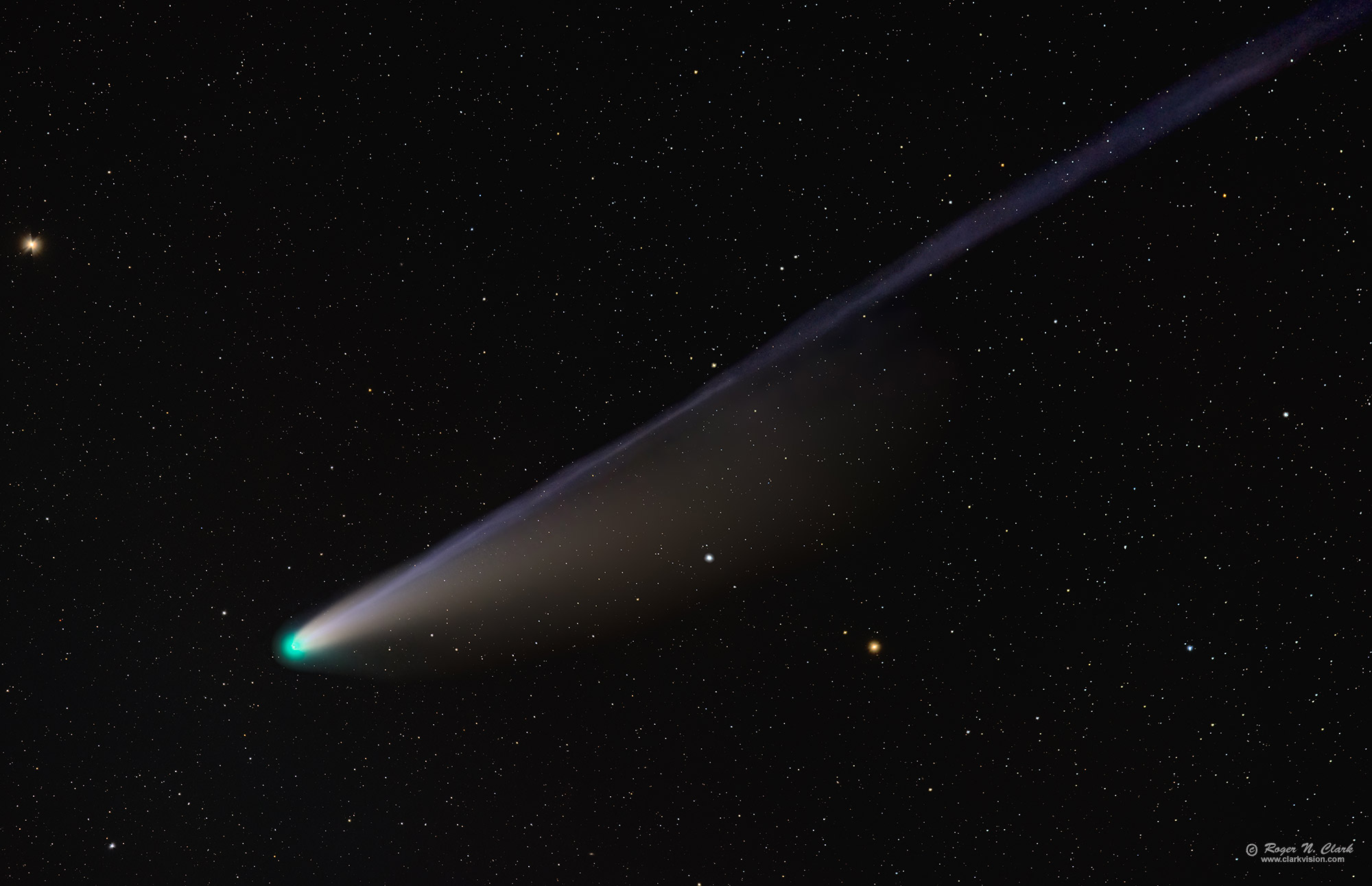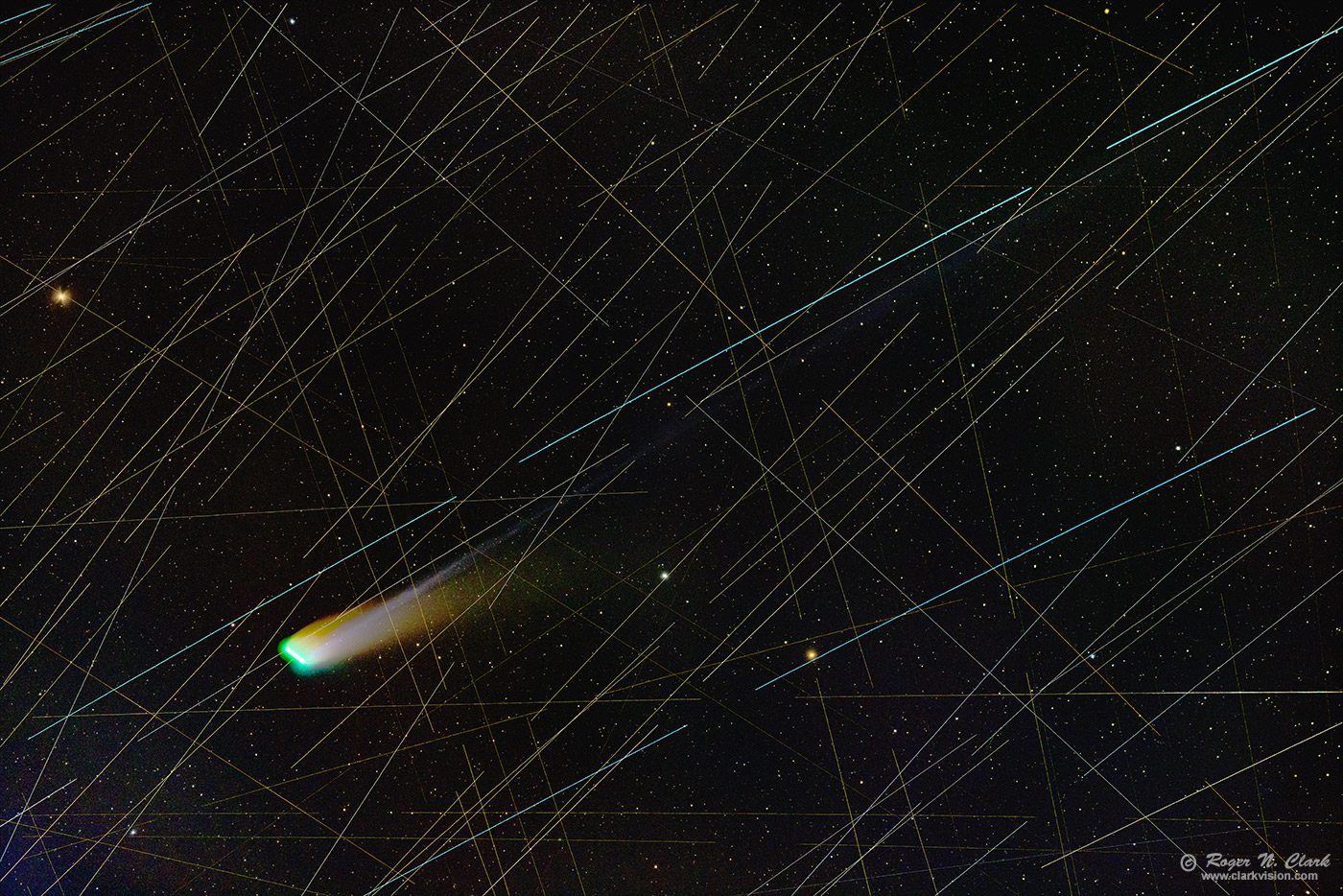| Home | Galleries | Articles | Reviews | Best Gear | New | About | Contact | Gallery Index | Previous |
Next |

| Home | Galleries | Articles | Reviews | Best Gear | New | About | Contact | Gallery Index | Previous |
Next |

Comet Lemon was a bright comet visible in the evening sky. In this image, obtained October 21, 2025 (MDT) in the Colorado Rocky mountains at an elevation of 11,170 feet, thus above much atmospheric absorption and light pollution from the Denver metro area, but the sky was still Bortle 5. In this photo, the blue ion tail (Type 1) gets it color mainly from CO+ emitting at 425 - 427 nm. The ion tail measures 5.7 degrees long from the comet nucleus to the upper corner. The yellow-brown dust tail (Type 2) extends about 3.1 degrees and is dragged into a fan shape by the solar radiation pressure on tiny dust grains, along with the orbital motion of the comet. The green around the nucleus is fluorescence from diatomic carbon (C2) with possible contribution from cyanogen (CN).
The comet was visible with direct vision with unaided eyes, but I did not see either tail visually, but did see the tails in binoculars.
The image is natural color. Star color is close to what we would see with our eyes in telescopes: solar type stars are white, cooler stars yellow to orange and red, and stars hotter than our Sun are bluish-white.
Technical. This image was obtained with a stock Canon EOS R5 Mirrorless 45-megapixel digital camera and Canon 300 mm f/2.8 L IS II lens. Total exposure time was 20.8 minutes (78 15-second exposures) for the stars and comet plus short exposures to show detail in the head of the comet: 22 2.5 second exposures plus 24 1-second exposures, all at ISO 1600. This is a natural color image. Post processing: raw conversion with Photoshop ACR, which includes full calibration with bias in the EXIF data and flat field in the lens profile, daylight white balance, and application of the color correction matrix for natural color. Stacking with deep sky stacker on stars, and a second stacking run on the comet with ImagesPlus. Stretched with rnc-color-stretch, and final adjustments in photoshop. No darks, no flats, no bias frames measured (bias is in the camera EXIF data and a flat field is in the ACR lens profile and corrected during raw conversion). Dark current is suppressed. The exposures were tracked on an iOptron HAE29EC strain wave mount with no guiding.
Original plate scale is 3.02 arc-seconds/pixel and this image is shown at about 1/4 resolution 11.2 arc-seconds/pixel.
This is a natural color image.
The Exposure Factors, CEF, CEFA are measures of the relative amounts of light received from a subject. It can be used to fairly compare wildly different lens/telescope apertures and exposure times. For this image on the sky:
The Satellites in the Field of View
Modern astrophotography has to deal with many dozens of satellites. The image below is the same data as that used to produce the above comet image, except processed differently. The above image used what is called sigma clipped average, rejecting data that was outside of 2 standard deviations in each pixel. This effectively eliminates pixels with a change in one image, or changes in just a few images out of a large set, thus rejecting satellites and airplanes. The image below was processed to find the maximum signal in the set of 78 15-second exposures, and that kept transient signals. The alignment for this image was on the stars, and the comet was moving among the stars so is blurred in the 31 minutes to acquire the set of images. As the numbers of satellites grows, a single pixel may experience multiple satellites and rejection becomes more difficult. A few years ago, this was not much of a problem. But this image, obtained on October, 21, 2025 shows many dozens of satellites. Now, short term phenomenon, like photographing meteor showers is much more difficult.

Note the different colors of the satellites. The yellow is likely due to the gold thermal blankets used on many spacecraft.
Modern digital cameras like the Canon R5 include on sensor dark current suppression technology and low fixed pattern noise at ISOs around 800 and higher, making no need for dark frame subtraction. Modern raw converters correct for light fall-off and also correct for hot/dead/stuck pixels. This makes processing low light images easy: simply align and average.
Also see Astrophotography Image Processing Basic Work Flow.
To learn how to obtain stunning images like this, please visit my Extensive Articles on Photography .
Keywords to this image = astrophoto-1 comet low-light digital_astro canon_r5 rnc-color-stretch NEW
Image ID: comet-lemon-2025-10-21-300mm-rnclark-4C3A4714-846-av78-e-2000s.jpg
| Home | Galleries | Articles | Reviews | Best Gear | Science | New | About | Contact |
Last updated November 08, 2025